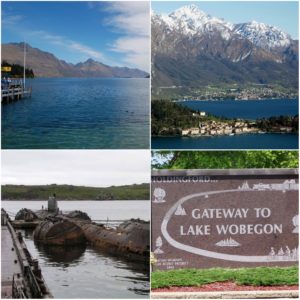By Ted McEnroe, Director of Research and Training
I was reviewing data from the State of Community Management from the 2016 report when a data point caught my attention that wasn’t part of the initial publication. Even at the Stage 1, our lowest level of community maturity, nearly half of community leaders said they were satisfied with their community culture. How could this be? I had noticed the sharp correlation between community maturity and satisfaction with culture – our most mature communities were almost universal in their satisfaction. That didn’t surprise me. But I wondered about those early stage communities, some decades old, where satisfaction outstripped levels of success.
And because it’s summer, I started to think about communities as famous lakes.

Clockwise from lower left: Lake Karachay, Russia; Lake Wakatipu, New Zealand; Lake Como, Italy; Lake Wobegon, USA
The place everyone wants to go we’ll call Lake Como, after the Italian lake that draws the rich and powerful to its beautiful shores. It’s the place you want to be – breathtaking in its beauty, active with people enjoying their time there, and the evidence of its wealthy, success attracting people is all around you – beautiful villas, upbeat conversation. It’s a hot spot – it knows who it is and embraces it. It may not be everyone’s cup of tea, but it works. It takes savvy management to keep Lake Como from jumping the shark – but it’s got the ability to demonstrate engagement and impact.
Everything the “Lake Como” community offers, the “Lake Karachay” community doesn’t. Lake Karachay is a Russian lake in the Ural Mountains that is so polluted that just standing next to it for an hour gives you a radiation overdose. It’s a place almost beyond salvage. It will need either a massive investment or just the acceptance that it’s easier to start someplace else than fix this one. Maybe Lake Karachay can be reclaimed with enough ambition and investment, but it won’t be easy.
Then there are those communities with potential. I honeymooned in New Zealand and was struck by the stunning beauty of Lake Wakatipu. It was beautiful, not overly developed, and loaded with possibilities. Some early communities are at this most excellent place. They have room to grow, but how they do is up to the manager. You can go big. You can stay intimate. You can attract investment and new members, or you can focus on behaviors and value. In the meantime – “Lake Wakatipu” is a community its members truly value and appreciate, and it’s great.
If that’s where you want your community to be – here’s the place you don’t. Welcome to Lake Wobegon.
But Lake Wobegon looks like a beautiful place. Its surface stats are wonderfully above average – and community leaders are happy to keep the illusion alive. They point to the number of members, the number of posts, and pat themselves on the back. Executive see the stats, too, and are pleased.
That is, until times get tough, or someone asks what’s really going on. What’s the value of Wobegon? What’s the purpose of Wobegon? Does it solve problems, foster solutions, or answer questions? At Wobegon, not really. There’s engagement, maybe – but not enough value. Behaviors that matter don’t change, and when times get tough, Lake Wobegon fades away.
Truth is, while Lake Karachay is a miserable and knows it, Lake Como flaunts what it’s got, and Lake Wakatipu’s visitors cherish it. Lake Wobegon is dangerous. Its good looks are a false face.
As a manager of a successful community – ask yourself: “Can we define our value?” “Can we measure it?” “Do we have a strategy, systems and tactics to keep it up?”
If you think your community is doing great – you may be right.
Just make sure you’re not Wobegon.
